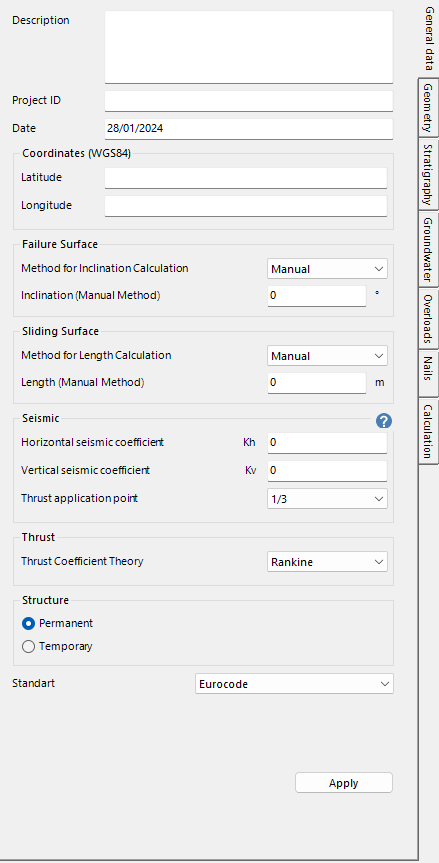The General Data panel appears as shown in the following figure.

This panel is used to assign the following data.
FAILURE SURFACE
This is the failure surface used to perform internal stability checks. Reference is made to the method by Sheahan and Ho (2003), suggested by American guidelines AASHTO, based on the assumption of a planar failure surface. There are two methods for calculating the slope of the failure surface:
•Manual: The user defines the value.
•Automatic: The software calculates the slope using the formula 45° + phi'/2 (Rankine's theory).
SLIDING SURFACE
This is the sliding surface at the base of the soil nailing structure, on which the sliding verification on the bedding plane is performed. There are three methods for calculating the length of the sliding surface:
•Manual: The user defines the value.
•BL = H: The length of the sliding surface is assumed to be equal to the height of the soil nailing wall.
•Automatic: The length of the sliding surface is calculated using the following expression
![]()
where:
•z1 represents the depth of the first nail from the top of the wall,
•L1 is the length of the nail,
•α1 is the inclination of the same nail.
SEISMIC
In this section, you need to define:
•The horizontal seismic coefficient, kh.
•The vertical seismic coefficient, kv.
•The point of application of the seismic action.
THEORY FOR THE CALCULATION OF THE THRUST COEFFICIENT
In this section, you need to choose the theory to refer to for the calculation of the thrust coefficient. Two options are available: Rankine and Coulomb. These methods are used in the case of static analysis (kh = kv = 0). In the case of pseudostatic analysis (kh > 0), the software will directly refer to the Mononobe-Okabe solution.
TYPE OF STRUCTURE
It can be permanent or temporary.